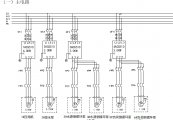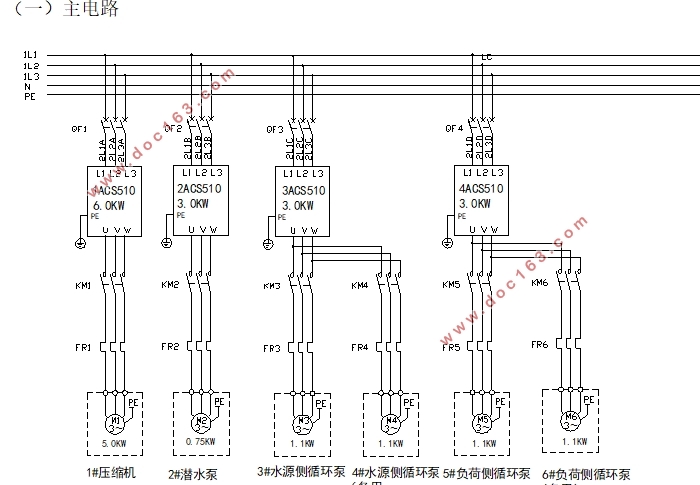水源热泵自动控制系统的设计

水源热泵自动控制系统的设计(任务书,论文13000字,CAD图纸,程序)
摘 要
目前,人类所面临的重大挑战之一就是能源问题,合理并高效的利用地能资源是缓解能源问题的有效途径。水源热泵是可以将热量从低温热源传送到高温热源的设备,但现阶段所采用的控制系统能耗很大,因而优化控制系统,降低能耗便成为提高系统的关键所在。
本文通过理论推导结合实际数据分析,从硬件和软件两方面来讲述水源热泵自动控制系统过程,使控制系统可以随负载变化对系统进行实时控制,降低了系统能耗,提高了系统控制精度。在控制过程中主要应用PLC并结合变频器来对空调系统进行精确的温度控制。软件方面采用模块化结构的梯形图语言来进行程序设计,便于扩展和更改,与此同时,运用组态软件将控制系统和数字仿真有机结合实现实时监控的功能,系统通过仿真的方式分析了设计的可行性。
关键词:水源热泵 变频控制 MCGS组态监控 可编程逻辑控制器
The design and implementation of automatic control system of water source heat pump
Abstract
At present, one of the major challenges facing human beings is the energy problem, the reasonable and efficient use of energy resources is an effective way to alleviate the problem of energy. Water source heat pump is the equipment to transfer heat quantity from low-temperature heat source to high temperature heat source, but at the present stage,control system energy consumption greatly, thus the optimal control system, reduce the energy consumption has become the key to improve the system. [资料来源:http://Doc163.com]
In this paper, the theory is combined with the actual data analysis, from two aspects of hardware and software to tell the story of water source heat pump automatic control process of the system, so that the control system can change with the load of real-time control of the system and reduce the energy consumption of the system, improve the accuracy of control system. In the control process, the main application of PLC and the frequency converter to control the air conditioning system for precise temperature control. Software used modular structure of ladder diagram language to program design, to facilitate the expansion and the change. At the same time, the use of configuration software control system and digital simulation of organic combination to achieve the function of real-time monitoring, simulation and analysis of the control system design is feasible.
Key Words: Water source heat pump; Variable frequency control; MCGS configuration monitoring; Programmable logic controller
[来源:http://Doc163.com]



目 录
摘 要 I
Abstract II
第一章 引言 1
1.1 研究背景 1
1.2 水源热泵控制系统的发展与现状 1
1.2.1 水源热泵发展概况 1
1.2.2 水源热泵发展现状 2 [资料来源:http://www.doc163.com]
第二章 变频调速在水源热泵空调系统的应用 4
2.1 水源热泵系统的工作原理 4
2.1.1 水源热泵的定义 4
2.1.2 水源热泵的工作原理 4
2.2 水源热泵系统的特点 5
2.2.1 属于可再生能源利用 5
2.2.2 属于经济有效的节能技术 5
2.2.3 环境效益显著 6
2.3 变频器的概述 6
2.3.1 普通空调与变频空调的对比 6
2.3.2 变频器的基本结构 6
2.3.3 变频器的控制方式 7
2.4 变频节能原理 7
2.4.1 泵类负载变频节能 7
2.5 水源热泵空调系统的变频控制方案 9
2.5.1 地热水水源侧变频控制方案 9
2.5.2 地热水用户侧循环泵变频控制方案 9
第三章 水源热泵自动控制系统的硬件设计 10
3.1 PLC 可编程逻辑控制器概述 10 [资料来源:http://www.doc163.com]
3.1.1 PLC基本单元及相关模块选定 10
3.1.2 系统I/O分配 11
3.2 设备选型相关参数 11
3.2.1 设计计算参数 12
3.2.2 负荷计算 13
3.2.3厂房地下水总水量的确定 13
3.3 水源热泵系统主电路的设计 14
3.3.1 水源热泵系统主电路的工作原理 14
3.3.2 压缩机的选型 15
3.3.3 泵的选型 15
3.3.4 热继电器的选型 16
3.4 水源热泵系统控制电路的设计 16
3.4.1 控制电路的工作原理 16
3.4.2接触器的选型 17
3.4.3 中间继电器的选型 18
第四章 水源热泵自动控制系统软件设计 19
4.1 PLC控制程序设计 19
4.1.1 STEP 7-MicroWIN32编程软件介绍 19
4.1.2 系统程序设计 19
4.2 监控软件MCGS 21 [资料来源:Doc163.com]
4.2.1 MCGS组态软件的介绍 21
4.2.2 图形界面的组态 22
4.3 PLC与组态软件的通讯 27
第五章 结语 28
参考文献 29
致谢 31
附件1 32
附件2 35 [资料来源:http://Doc163.com]
